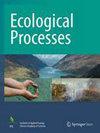Fine spatial scale assessment of structure and configuration of vegetation cover for northern bobwhites in grazed pastures
IF 3.9
2区 环境科学与生态学
Q1 ECOLOGY
引用次数: 0
Abstract
Monitoring forage in livestock operations is critical to sustainable rangeland management of soil and ecological processes that provide both livestock and wildlife habitat. Traditional ground-based sampling methods have been widely used and provide valuable information; however, they are time-consuming, labor-intensive, and limited in their ability to capture larger extents of the spatial and temporal dynamics of rangeland ecosystems. Drones provide a solution to collect data to larger extents than field-based methods and with higher-resolution than traditional remote sensing platforms. Our objectives were to (1) assess the accuracy of vegetation cover height in grasses using drones, (2) quantify the spatial distribution of vegetation cover height in grazed and non-grazed pastures during the dormant (fall–winter) and growing seasons (spring–summer), and (3) evaluate the spatial distribution of vegetation cover height as a proxy for northern bobwhite (Colinus virginianus) habitat in South Texas. We achieved this by very fine scale drone-derived imagery and using class level landscape metrics to assess vegetation cover height configuration. Estimated heights from drone imagery had a significant relationship with the field height measurements in September (r2 = 0.83; growing season) and February (r2 = 0.77; dormant season). Growing season pasture maintained residual landscape habitat configuration adequate for bobwhites throughout the fall and winter of 2022–2023 following grazing. Dormant season pasture had an increase in bare ground cover, and a shift from many large patches of tall herbaceous cover (40–120 cm) to few large patches of low herbaceous cover (5–30 cm) (p < 0.05). Drones provided high-resolution imagery that allowed us to assess the spatial and temporal changes of vertical herbaceous vegetation structure in a semi-arid rangeland subject to grazing. This study shows how drone imagery can be beneficial for wildlife conservation and management by providing insights into changes in fine-scale vegetation spatial and temporal heterogeneity from livestock grazing.对放牧草场中北方山雀植被结构和配置的精细空间尺度评估
监测牲畜饲养中的草料对于可持续的牧场土壤管理以及提供牲畜和野生动物栖息地的生态过程至关重要。传统的地面采样方法已被广泛使用,并能提供有价值的信息;但这些方法耗时、耗力,而且在捕捉牧场生态系统更大范围的时空动态方面能力有限。与野外方法相比,无人机提供了一种收集更大范围数据的解决方案,其分辨率也高于传统遥感平台。我们的目标是:(1)使用无人机评估草地植被覆盖高度的准确性;(2)量化休眠期(秋冬季)和生长期(春夏季)放牧草地和非放牧草地植被覆盖高度的空间分布;以及(3)评估植被覆盖高度的空间分布,以此作为德克萨斯州南部北部山齿兔(Colinus virginianus)栖息地的替代物。为此,我们采用了非常精细的无人机图像,并使用等级景观指标来评估植被高度配置。无人机图像估算的高度与 9 月(r2 = 0.83;生长季节)和 2 月(r2 = 0.77;休眠季节)的实地高度测量值有显著关系。在放牧后的 2022-2023 年整个秋冬季,生长季牧草保持了足够的剩余景观栖息地配置。休眠期牧场的裸露地面覆盖物增加,从许多大块高草本覆盖物(40-120 厘米)转变为少数大块低草本覆盖物(5-30 厘米)(p < 0.05)。无人机提供的高分辨率图像使我们能够评估受放牧影响的半干旱牧场垂直草本植被结构的时空变化。这项研究显示了无人机图像如何通过深入了解牲畜放牧造成的精细尺度植被空间和时间异质性的变化,为野生动物保护和管理带来益处。
本文章由计算机程序翻译,如有差异,请以英文原文为准。
求助全文
约1分钟内获得全文
求助全文
来源期刊

Ecological Processes
Environmental Science-Ecological Modeling
CiteScore
8.50
自引率
4.20%
发文量
64
审稿时长
13 weeks
期刊介绍:
Ecological Processes is an international, peer-reviewed, open access journal devoted to quality publications in ecological studies with a focus on the underlying processes responsible for the dynamics and functions of ecological systems at multiple spatial and temporal scales. The journal welcomes manuscripts on techniques, approaches, concepts, models, reviews, syntheses, short communications and applied research for advancing our knowledge and capability toward sustainability of ecosystems and the environment. Integrations of ecological and socio-economic processes are strongly encouraged.
 求助内容:
求助内容: 应助结果提醒方式:
应助结果提醒方式:


